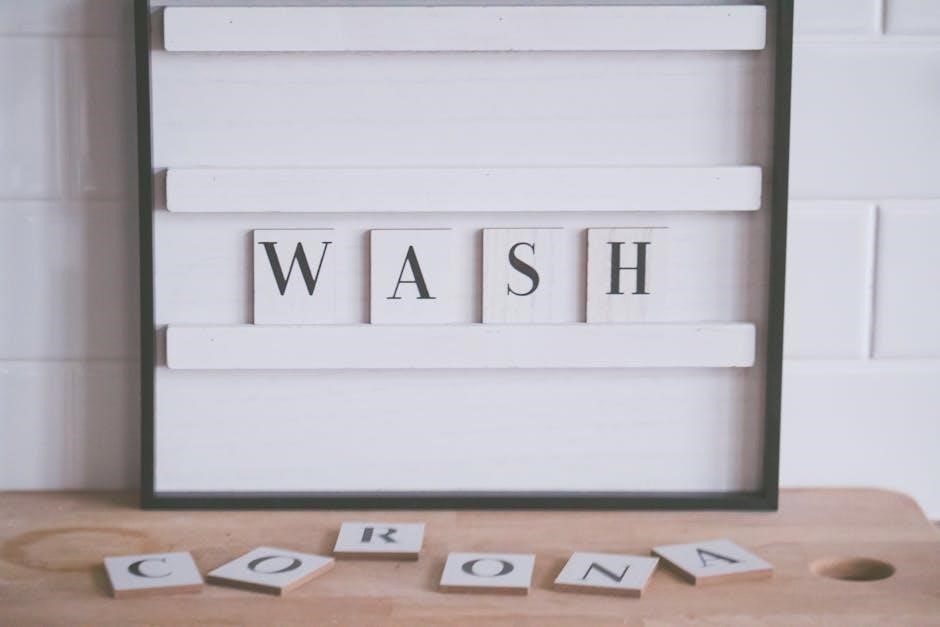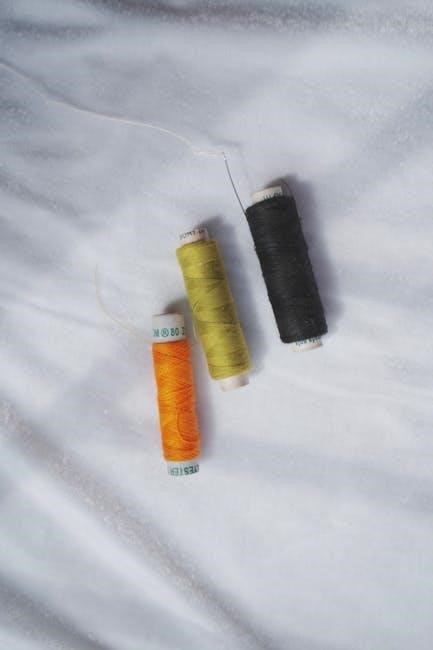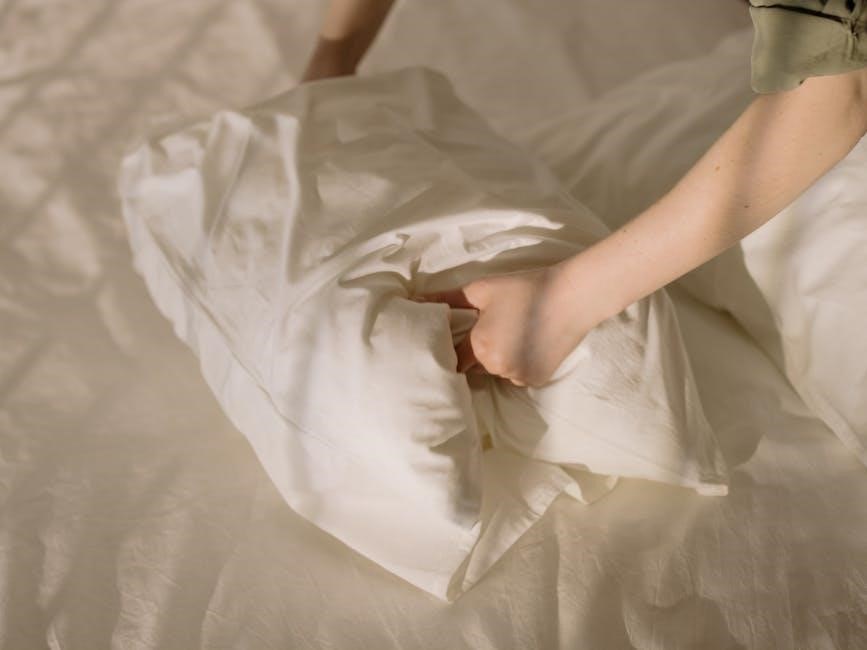Washing 100% cotton fabrics requires attention to detail to maintain softness and durability. Proper techniques prevent shrinking and fading‚ ensuring long-lasting comfort and a fresh appearance always.
Importance of Proper Washing Techniques
Proper washing techniques are crucial for maintaining the quality and longevity of 100% cotton fabrics. Improper methods can lead to shrinking‚ fading‚ or fabric damage‚ reducing the lifespan of your clothes. Understanding care labels ensures you use the right water temperature‚ detergent‚ and cycle for optimal results. Washing symbols guide you on whether to hand wash‚ machine wash‚ or dry clean‚ while bleaching and drying symbols prevent over-processing. Following these guidelines helps preserve the softness‚ color‚ and texture of cotton‚ ensuring it remains comfortable and visually appealing. Neglecting these steps can result in irreversible damage‚ making proper techniques essential for long-term fabric care.

Understanding Laundry Symbols for Cotton Fabrics
Laundry symbols on care labels provide essential guidance for washing‚ bleaching‚ drying‚ and ironing 100% cotton fabrics. These symbols are standardized to ensure clarity and consistency. A tub with waves indicates hand washing‚ while a machine tub signifies machine washing. Dots inside the tub represent water temperature: one dot for cold‚ two for warm‚ and three for hot. Bleaching symbols‚ such as a triangle‚ may include a diagonal line for chlorine-free options. Drying symbols‚ like a square‚ indicate methods: dots for temperature‚ a horizontal line for air drying‚ and a curved line for natural drying. Ironing symbols‚ such as a dot pattern‚ specify heat levels. These symbols help prevent damage and ensure fabrics are cared for properly.
Understanding Care Labels for 100% Cotton
Care labels for 100% cotton fabrics provide symbols and instructions for washing‚ bleaching‚ drying‚ ironing‚ and professional cleaning‚ ensuring proper care and preservation of the fabric.
Deciphering Washing Symbols on Labels
Washing symbols on care labels provide essential guidance for cleaning 100% cotton fabrics. A tub filled with water indicates the washing method‚ while lines or dots below suggest water temperature. A hand symbol means hand washing is recommended‚ and underlining indicates gentle cycles. A circle with an “X” prohibits certain methods‚ like machine washing. Understanding these symbols ensures fabrics are cleaned correctly‚ preventing damage or shrinkage. Always check the label to determine if cold water‚ bleach‚ or specific detergents are advised. Proper decoding helps maintain fabric quality and longevity‚ ensuring your 100% cotton items remain soft‚ vibrant‚ and durable for years to come.
Bleaching Symbols and Their Meanings
Bleaching symbols on care labels guide safe use of bleach on 100% cotton fabrics. A triangle symbolizes bleach compatibility‚ while a triangle with an “X” prohibits its use. A triangle with diagonal lines indicates only color-safe bleach is allowed. Chlorine bleach can weaken or discolor cotton‚ so following these symbols is crucial. Always check the label to ensure safe bleaching practices‚ as improper use can damage fibers or cause fading. These symbols help preserve fabric integrity and maintain vibrancy‚ ensuring cotton remains soft and durable over time. Proper bleaching techniques are vital for extending the life of your cotton items while keeping them clean and fresh.
Drying Symbols Explained
Drying symbols on care labels provide clear instructions for properly drying 100% cotton fabrics. A square symbol represents drying‚ with variations indicating natural or machine drying. A square with a horizontal line means natural drying‚ while a square with diagonal lines suggests tumble drying on a low heat setting. Some symbols may include dots or numbers to specify temperature levels. Proper drying prevents shrinking‚ fading‚ and fabric stress. Natural drying is recommended to maintain softness and color vibrancy‚ while machine drying on low heat is also acceptable. Always follow these symbols to ensure your cotton fabrics retain their quality and longevity. Proper drying techniques are essential for preserving the integrity of cotton materials over time.
Ironing Symbols for Cotton Fabrics
Ironing symbols on care labels guide how to safely iron 100% cotton fabrics. The iron symbol indicates the fabric can be ironed‚ with dots below specifying temperature: one dot for low heat‚ two for medium‚ and three for high. A crossed-out iron means no ironing is allowed. For cotton‚ a medium to high heat setting is typically recommended‚ but always check the label. Steam may be used unless specified otherwise. Ironing cotton while slightly damp helps remove wrinkles easily. Avoid scorching by testing a small area first. Proper ironing preserves the fabric’s texture and appearance‚ ensuring cotton remains soft and smooth over time;
Professional Cleaning Symbols
Professional cleaning symbols on care labels provide guidance for specialized cleaning methods. These symbols may include letters like “P” for perchloroethylene‚ “F” for hydrocarbon solvents‚ or “W” for water-based cleaning. A circle with a dot indicates wet cleaning‚ while a circle with a cross means dry cleaning is not recommended. Additional symbols inside the circle may specify specific treatments or solvents. Always consult a professional cleaner if unsure‚ as improper cleaning can damage fabrics. For 100% cotton‚ professional cleaning is often advised for heavily soiled or delicate items. These symbols ensure cotton fabrics receive the appropriate care‚ preserving their quality and appearance over time. Proper interpretation is key to maintaining the fabric’s integrity.

Pre-Wash Preparation for 100% Cotton
Pre-wash preparation involves sorting‚ checking for stains‚ and using the right detergent to ensure optimal cleaning and prevent damage or color bleeding.
Sorting Cotton Fabrics by Color
Sorting cotton fabrics by color is essential to prevent dye bleeding and ensure vibrant colors remain intact. Separate whites from colored fabrics to avoid discoloration. Dark and bright colors should be washed separately from lighter shades to prevent fading or unwanted color transfer. Check care labels for specific instructions‚ as some dyes may be more prone to bleeding. For heavily dyed fabrics‚ consider washing them separately the first few times. This step helps maintain the appearance of your garments and prevents ruining other clothes in the same load. Proper sorting ensures a cleaner‚ more professional-looking finish for all your cotton items.
Checking for Stains and Spot Treating
Before washing‚ inspect cotton fabrics for stains to ensure effective removal. Common stains like food‚ grass‚ or ink require immediate attention. Gently blot stains with a clean cloth to remove excess residue. For tough stains‚ apply a small amount of detergent or stain remover directly to the affected area. Let it sit for 5-10 minutes before washing. For oily stains‚ pre-treat with a laundry pre-treatment product or white vinegar. Avoid rubbing too hard‚ as it may damage the fabric. Spot treating prevents stains from setting in and ensures a cleaner wash. Always test a small‚ inconspicuous area first to avoid discoloration.
Using the Right Detergent for Cotton
Choosing the right detergent is crucial for washing 100% cotton fabrics. Opt for a mild or regular detergent designed for cotton‚ as harsh chemicals can damage fibers. Avoid using too much detergent‚ as residue can stiffen fabrics. For heavily soiled cotton‚ a heavy-duty detergent may be necessary. Always follow the dosage instructions on the detergent label to avoid overloading. Liquid detergents are often effective for cotton‚ while powder detergents can be just as good if measured correctly. For delicate or colored cotton‚ consider using a gentle or eco-friendly detergent to preserve softness and color vibrancy. The right detergent ensures a clean wash without compromising fabric quality or comfort.

Washing 100% Cotton in a Washing Machine
Wash 100% cotton in cold water using a gentle cycle. Check care labels for specific instructions. Avoid overloading the machine for optimal cleaning and fabric protection.
Recommended Water Temperature for Cotton
For 100% cotton fabrics‚ cold water is generally recommended to prevent shrinking and color fading. Use cold water (below 30°C) for dark or vibrant colors and delicate items. Hot water (above 40°C) is suitable for heavily soiled white or light-colored cotton fabrics but may cause shrinkage. Always check the care label for specific temperature guidance. Avoid using hot water for colored fabrics to maintain their vibrancy. For everyday washing‚ a moderate temperature (30-40°C) balances cleaning effectiveness and fabric protection. Excessively high temperatures can weaken cotton fibers over time‚ reducing the fabric’s longevity and softness.
Choosing the Right Wash Cycle
Selecting the appropriate wash cycle for 100% cotton fabrics is crucial to maintain their quality. A gentle cycle is ideal for delicate or lightly soiled cotton items to prevent damage. For heavily soiled fabrics‚ a normal or standard cycle is more effective. Avoid using harsh or heavy-duty cycles‚ as they can cause excessive agitation‚ leading to wear and tear. Always check the care label for specific cycle recommendations. Using the right cycle helps preserve the fabric’s texture and prevents shrinkage. For colored cotton‚ a shorter cycle with cold water is recommended to protect dyes. Proper cycle selection ensures a balance between cleaning efficiency and fabric longevity‚ keeping your cotton clothes looking their best for years to come.
Load Size and Spin Cycle Settings
Proper load size and spin cycle settings are essential for washing 100% cotton fabrics effectively. Avoid overloading the washing machine‚ as this can cause excessive abrasion and lead to fabric wear. A medium-sized load is ideal‚ allowing clothes to move freely during the wash cycle. For the spin cycle‚ a medium setting is recommended to remove excess water without damaging the fabric. High spin cycles can be too aggressive for delicate cotton items‚ while low settings may leave clothes too wet. Always check the care label for specific recommendations‚ as some fabrics may require gentler handling. Proper load and spin settings help maintain fabric softness and prevent shrinkage‚ ensuring your cotton clothes remain in great condition.

Hand Washing 100% Cotton Fabrics
Hand washing is a gentle and effective method for cleaning delicate or special-care 100% cotton fabrics. It helps preserve the fabric’s softness‚ color‚ and texture. Use cold water‚ a mild detergent‚ and gentle agitation to avoid damage. Avoid soaking for too long to prevent weakening the fibers. Rinse thoroughly to remove all soap residue. Gently squeeze out excess water without wringing‚ and lay flat to air dry‚ away from direct sunlight‚ to maintain shape and prevent fading. This method is ideal for items that require extra care.
When to Hand Wash Cotton
Hand washing is ideal for delicate or special-care 100% cotton items‚ such as brightly colored fabrics‚ embroidered garments‚ or those with beads or sequins. It is also recommended for new or dark-colored cotton to prevent fading. Hand washing is best for fabrics prone to shrinking or running colors‚ as it allows for gentle agitation and cold water. Additionally‚ heavily soiled or stained cotton items benefit from hand washing‚ as it enables targeted spot treatment. For items requiring extra care‚ such as lingerie or baby clothes‚ hand washing ensures a soft and hygienic clean; Avoid machine washing for intricate or fragile cotton fabrics to preserve their texture and appearance. Always check the care label for specific instructions.
Steps for Proper Hand Washing
Begin by filling a basin or sink with cold water‚ adding a mild detergent suitable for cotton. Submerge the fabric‚ gently agitating it with your hands for 2-3 minutes to distribute the soap. Avoid scrubbing or twisting‚ as this can damage fibers. Let it soak for 10-15 minutes to loosen dirt. Rinse thoroughly under cold running water until no soap remains. For stubborn stains‚ apply a stain remover and gently work it in before washing. After rinsing‚ remove excess water without wringing. Lay the item flat on a towel‚ reshaping it to its original dimensions to prevent stretching. Allow it to air dry away from direct sunlight to maintain color and texture.
Drying After Hand Washing
After hand washing‚ gently remove excess water without wringing or twisting the fabric‚ as this can stretch or damage the cotton. Lay the item flat on a clean‚ dry towel‚ reshaping it to its original dimensions to maintain texture. Avoid exposing it to direct sunlight‚ which can cause fading. Allow the fabric to air dry completely‚ away from heat sources like radiators or heaters. For delicate items‚ consider placing them on a drying rack indoors. Reshape the fabric while it’s still damp to ensure it dries smoothly; Do not hang wet cotton garments‚ as this can lead to stretching. Drying naturally preserves the softness and integrity of 100% cotton fabrics.

Drying 100% Cotton Fabrics
Air drying is best for 100% cotton to prevent shrinkage and fading. For machine drying‚ use a low setting. Remove promptly to avoid wrinkles and maintain shape.
Machine Drying Tips for Cotton
Machine drying cotton fabrics requires careful attention to prevent shrinkage and maintain softness. Always use a low heat setting‚ as high heat can cause fibers to shrink and colors to fade. Remove cotton items as soon as the drying cycle ends to minimize wrinkles. Using a clean lint filter is essential to improve airflow and reduce the risk of fire. For best results‚ avoid overloading the dryer‚ as this can cause uneven drying and potential damage. If possible‚ consider air drying or removing cotton fabrics while still slightly damp to let them finish drying naturally. This helps preserve the fabric’s integrity and texture. Checking the care label for specific drying instructions is also recommended to ensure optimal results.
Best Practices for Air Drying Cotton
Air drying cotton fabrics is a gentle and effective way to preserve their quality. Hang cotton clothes in a well-ventilated area‚ away from direct sunlight to prevent fading. Reshape garments while still damp to maintain their original fit. For delicate items‚ lay them flat on a clean towel to dry. Avoid leaving cotton fabrics in humid environments‚ as this can lead to musty odors. If drying indoors‚ ensure good airflow to speed up the process. Hanging clothes on a sturdy hanger or drying rack is ideal. For jeans‚ hanging them by the waistband helps maintain shape. Always check the care label for specific drying recommendations‚ as some cotton items may require special care. Air drying is a simple‚ eco-friendly method to keep cotton soft and durable.

Ironing and Folding 100% Cotton Fabrics
Ironing cotton fabrics requires a medium heat setting to avoid scorching. Use steam for wrinkle removal and fold clothes while slightly damp to maintain shape and prevent stretching.
Ironing Cotton Fabrics Safely
Ironing cotton fabrics safely requires attention to temperature settings to avoid damage. Use a medium heat setting‚ as cotton fibers can withstand moderate heat but may scorch at higher temperatures. Ensure fabrics are slightly damp for easier wrinkle removal‚ and always iron while the fabric is still damp to avoid burning. For stubborn wrinkles‚ steam can be used‚ but avoid prolonged steam exposure to prevent weakening the fabric. Delicates or printed fabrics should be ironed inside out to protect designs. Never iron cotton fabrics with excessive steam or on finishes like wax or water-repellent coatings‚ as this can damage the material. Always keep children away and unplug the iron after use for added safety.
Proper Folding Techniques
Proper folding techniques are essential for maintaining the quality and appearance of 100% cotton fabrics. Fold clothes immediately after drying to prevent wrinkles and creases. For casual items like t-shirts‚ the simple fold is effective: lay the garment flat‚ fold the sides to the center‚ and then fold the bottom up. For more structured items‚ like dresses or trousers‚ consider the KonMari fold‚ which involves folding items into small rectangles for neat storage. Avoid over-folding‚ as this can cause unnecessary creases. Store folded cotton fabrics in a cool‚ dry place to maintain their softness and prevent shrinkage. Proper folding also helps reduce wrinkles‚ making ironing easier when needed.

Removing Stains from 100% Cotton
Act quickly to treat stains on cotton fabrics. Identify the stain type‚ apply a suitable remover‚ and wash in cold water. Avoid heat to prevent setting stains.
Common Stains and How to Remove Them
Common stains on 100% cotton fabrics include food spills‚ grass‚ grease‚ and ink. For food stains‚ blot excess immediately and pre-treat with a mild detergent or stain remover. Grass stains can be removed by soaking in cold water with laundry detergent or vinegar. Grease stains respond well to pre-treatment with dish soap or stain removers before washing. Ink stains may require repeated washing or specialized products. Always check the care label and avoid using hot water‚ as it can set stains permanently. For best results‚ address stains promptly and wash in cold water to preserve fabric quality and color.
- Food spills: Blot and pre-treat with detergent.
- Grass: Soak in cold water with detergent or vinegar.
- Grease: Use dish soap or stain remover before washing.
- Ink: Repeat washing or use specialized products.
Remember‚ prompt action and cold water are key to effective stain removal.
Using Bleach on Cotton Fabrics
When using bleach on 100% cotton fabrics‚ it’s essential to exercise caution. Chlorine bleach is effective for whitening but can weaken or yellow cotton over time. Oxygen bleach is gentler and safer for colors. Always check the care label for bleach recommendations. Dilute bleach in water before adding to the wash‚ and avoid using it on colored or printed fabrics unless specified. For whites‚ a small amount of chlorine bleach can enhance brightness‚ but excessive use may damage fibers. Spot testing is recommended to ensure fabric compatibility. Avoid bleaching at high temperatures‚ as it can degrade cotton fibers.
- Chlorine bleach: Suitable for whites‚ but use sparingly.
- Oxygen bleach: Gentler and color-safe.
- Colored fabrics: Avoid bleaching unless labeled safe.

Always follow instructions and test a small area first.

Long-Term Care for 100% Cotton Fabrics
Store cotton clothes in breathable containers to prevent moisture buildup. Avoid direct sunlight to preserve colors. Fold or hang neatly to maintain shape and softness over time.
Storage Tips for Cotton Clothes
Proper storage is essential for preserving the quality of 100% cotton fabrics. Use breathable containers or cloth bags to allow air circulation and prevent moisture buildup. Avoid plastic bags‚ as they can trap humidity and lead to mold. Fold clothes neatly or hang them on sturdy hangers to maintain their shape. Store in a cool‚ dry place away from direct sunlight to avoid fading. For seasonal items‚ consider using natural fiber storage bags to repel pests. Separate colors to prevent dye transfer and ensure clothes are clean before storing‚ as dirt can attract insects. This will help maintain softness and prevent damage over time.
Maintaining Softness and Color
To preserve the softness and color of 100% cotton fabrics‚ wash them in cold water to prevent shrinking and fading. Avoid using harsh detergents or fabric softeners‚ as they can leave residues that dull colors and stiffen the fabric. Instead‚ add a 1/2 cup of white vinegar during the rinse cycle to naturally soften fibers. For vibrant colors‚ turn garments inside out before washing to reduce friction and dye loss. Use a mild detergent designed for colors and opt for a gentle wash cycle. Air-dry clothes indoors or in the shade to avoid sun fading. Avoid over-drying‚ as it can make cotton stiff. Store clean‚ dry clothes in a cool‚ dark place to maintain their texture and color.
Proper washing techniques ensure 100% cotton fabrics remain soft‚ vibrant‚ and durable. By following care labels and using gentle methods‚ you preserve their quality for years to come.
Washing 100% cotton fabrics requires careful attention to maintain their quality. Always check care labels for specific instructions. Separate colors to prevent bleeding and pre-treat stains before washing. Use cold water to avoid shrinking and fading‚ and choose a gentle detergent. Avoid overloading the washing machine to prevent fabric stress. Opt for a delicate cycle or hand washing for sensitive items. For drying‚ air-dry or use a low-heat setting to protect fibers. Avoid using bleach unless specified‚ as it can weaken cotton. Proper washing and drying techniques ensure softness‚ durability‚ and longevity of your cotton fabrics. Regular maintenance helps preserve their appearance and comfort over time.
Final Tips for Preserving Cotton Fabrics
Preserving 100% cotton fabrics involves careful attention to washing‚ drying‚ and storage. Always wash in cold water to prevent shrinking and fading. Use a gentle detergent to maintain softness and avoid harsh chemicals. Air-drying is ideal‚ as machine drying can weaken fibers over time. Store cotton clothes in a cool‚ dry place to prevent moisture buildup and pests. Avoid direct sunlight‚ as it can cause fading. Fold clothes instead of hanging to reduce stretching. For long-term storage‚ use breathable bags or containers. Regularly cleaning and storing cotton fabrics properly ensures they remain soft‚ vibrant‚ and durable for years. These simple practices help maintain the natural beauty of cotton.

Leave a Reply
You must be logged in to post a comment.